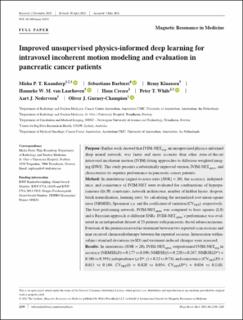| dc.contributor.author | Kaandorp, Misha Pieter Thijs | |
| dc.contributor.author | Barbieri, Sebastiano | |
| dc.contributor.author | Klaassen, Remy | |
| dc.contributor.author | van Laarhoven, Hanneke W. M. | |
| dc.contributor.author | Crezee, Hans | |
| dc.contributor.author | While, Peter Thomas | |
| dc.contributor.author | Nederveen, Aart J. | |
| dc.contributor.author | Gurney-Champion, Oliver J. | |
| dc.date.accessioned | 2021-10-04T09:28:48Z | |
| dc.date.available | 2021-10-04T09:28:48Z | |
| dc.date.created | 2021-09-29T12:04:33Z | |
| dc.date.issued | 2021 | |
| dc.identifier.citation | Magnetic Resonance in Medicine. 2021, 86, 2250-2265. | en_US |
| dc.identifier.issn | 0740-3194 | |
| dc.identifier.uri | https://hdl.handle.net/11250/2787414 | |
| dc.description.abstract | Purpose Earlier work showed that IVIM-NETorig, an unsupervised physics-informed deep neural network, was faster and more accurate than other state-of-the-art intravoxel-incoherent motion (IVIM) fitting approaches to diffusion-weighted imaging (DWI). This study presents a substantially improved version, IVIM-NEToptim, and characterizes its superior performance in pancreatic cancer patients. Method In simulations (signal-to-noise ratio [SNR] = 20), the accuracy, independence, and consistency of IVIM-NET were evaluated for combinations of hyperparameters (fit S0, constraints, network architecture, number of hidden layers, dropout, batch normalization, learning rate), by calculating the normalized root-mean-square error (NRMSE), Spearman’s ρ, and the coefficient of variation (CVNET), respectively. The best performing network, IVIM-NEToptim was compared to least squares (LS) and a Bayesian approach at different SNRs. IVIM-NEToptim’s performance was evaluated in an independent dataset of 23 patients with pancreatic ductal adenocarcinoma. Fourteen of the patients received no treatment between two repeated scan sessions and nine received chemoradiotherapy between the repeated sessions. Intersession within-subject standard deviations (wSD) and treatment-induced changes were assessed. Results In simulations (SNR = 20), IVIM-NEToptim outperformed IVIM-NETorig in accuracy (NRMSE(D) = 0.177 vs 0.196; NMRSE(f) = 0.220 vs 0.267; NMRSE(D*) = 0.386 vs 0.393), independence (ρ(D*, f) = 0.22 vs 0.74), and consistency (CVNET(D) = 0.013 vs 0.104; CVNET(f) = 0.020 vs 0.054; CVNET(D*) = 0.036 vs 0.110). IVIM-NEToptim showed superior performance to the LS and Bayesian approaches at SNRs < 50. In vivo, IVIM-NEToptim showed significantly less noisy parameter maps with lower wSD for D and f than the alternatives. In the treated cohort, IVIM-NEToptim detected the most individual patients with significant parameter changes compared to day-to-day variations. Conclusion IVIM-NEToptim is recommended for accurate, informative, and consistent IVIM fitting to DWI data. | en_US |
| dc.language.iso | eng | en_US |
| dc.publisher | Wiley Periodicals LLC on behalf of International Society for Magnetic Resonance in Medicine | en_US |
| dc.relation.uri | https://onlinelibrary.wiley.com/doi/full/10.1002/mrm.28852 | |
| dc.rights | Navngivelse 4.0 Internasjonal | * |
| dc.rights.uri | http://creativecommons.org/licenses/by/4.0/deed.no | * |
| dc.title | Improved unsupervised physics-informed deep learning for intravoxel incoherent motion modeling and evaluation in pancreatic cancer patients | en_US |
| dc.type | Peer reviewed | en_US |
| dc.type | Journal article | en_US |
| dc.description.version | publishedVersion | en_US |
| dc.source.pagenumber | 2250-2265 | en_US |
| dc.source.volume | 86 | en_US |
| dc.source.journal | Magnetic Resonance in Medicine | en_US |
| dc.identifier.doi | 10.1002/mrm.28852 | |
| dc.identifier.cristin | 1940500 | |
| dc.relation.project | Norges forskningsråd: 302624 | en_US |
| cristin.ispublished | true | |
| cristin.fulltext | original | |
| cristin.qualitycode | 2 | |

